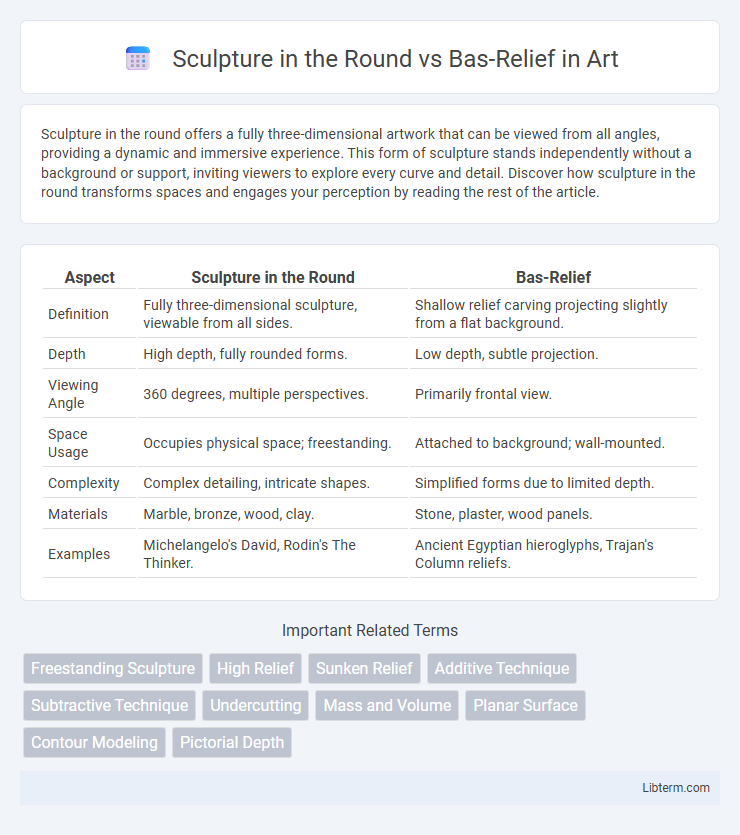Sculpture in the round offers a fully three-dimensional artwork that can be viewed from all angles, providing a dynamic and immersive experience. This form of sculpture stands independently without a background or support, inviting viewers to explore every curve and detail. Discover how sculpture in the round transforms spaces and engages your perception by reading the rest of the article.
Table of Comparison
| Aspect | Sculpture in the Round | Bas-Relief |
|---|---|---|
| Definition | Fully three-dimensional sculpture, viewable from all sides. | Shallow relief carving projecting slightly from a flat background. |
| Depth | High depth, fully rounded forms. | Low depth, subtle projection. |
| Viewing Angle | 360 degrees, multiple perspectives. | Primarily frontal view. |
| Space Usage | Occupies physical space; freestanding. | Attached to background; wall-mounted. |
| Complexity | Complex detailing, intricate shapes. | Simplified forms due to limited depth. |
| Materials | Marble, bronze, wood, clay. | Stone, plaster, wood panels. |
| Examples | Michelangelo's David, Rodin's The Thinker. | Ancient Egyptian hieroglyphs, Trajan's Column reliefs. |
Introduction to Sculpture in the Round and Bas-Relief
Sculpture in the round is a three-dimensional work designed to be viewed from all angles, emphasizing form, volume, and spatial depth. Bas-relief, by contrast, is a low-relief sculptural technique where figures slightly project from a flat background, creating a subtle sense of depth without full dimensionality. Both forms highlight different artistic approaches in conveying narrative and texture, with sculpture in the round offering complete physical presence and bas-relief focusing on surface intricacy.
Defining Sculpture in the Round
Sculpture in the round is a fully three-dimensional artwork that can be viewed from all sides, standing independently without a background or support. This type of sculpture emphasizes volume and depth, allowing viewers to experience the form in a dynamic spatial context. Unlike bas-relief, which is limited to shallow depth and a fixed viewpoint, sculpture in the round provides complete immersion and interaction with the sculpted figure.
Understanding Bas-Relief Sculpture
Bas-relief sculpture involves shallow carving where figures slightly project from the background, creating a subtle three-dimensional effect while maintaining a strong connection to the flat surface. This technique contrasts with sculpture in the round, which is fully three-dimensional and freestanding, allowing viewers to perceive the work from multiple angles. Understanding bas-relief requires recognizing its emphasis on depth illusion and surface detail, often used in architectural decoration and narrative storytelling on walls and monuments.
Historical Origins and Evolution
Sculpture in the round, characterized by fully three-dimensional forms viewable from all angles, traces its origins to prehistoric times with examples like the Venus of Willendorf dating back to around 28,000 BCE. Bas-relief, or low relief, involves shallow carving where figures slightly project from a flat background, emerging prominently in ancient Mesopotamian and Egyptian art circa 3000 BCE for narrative storytelling on monuments. Over centuries, both forms evolved: sculpture in the round emphasizing lifelike presence and volume during the Renaissance, while bas-relief continued to adorn architectural friezes and coins, preserving historical narratives through subtle depth and intricate detail.
Key Differences in Technique and Form
Sculpture in the round is a fully three-dimensional artwork that can be viewed from all angles, emphasizing depth and volume with free-standing forms. Bas-relief involves carving or molding a shallow depth into a flat surface, where figures project slightly from the background, creating an illusion of depth without complete detachment. The key difference lies in the dimensionality and viewing experience: sculpture in the round occupies space independently, while bas-relief integrates images within a two-dimensional plane.
Materials Commonly Used in Both Styles
Sculpture in the round typically employs materials such as marble, bronze, wood, and clay, chosen for their durability and ability to be viewed from all angles. Bas-relief commonly uses stone, plaster, metal sheets, and terracotta, allowing intricate details to be carved or molded on flat surfaces. Both styles utilize versatile substances like bronze and clay, enabling artists to achieve diverse textures and finishes according to the desired artistic effect.
Artistic Purposes and Symbolism
Sculpture in the round offers a fully three-dimensional form that viewers can experience from multiple angles, emphasizing realism and inviting interaction with its spatial presence to convey themes of vitality and human experience. Bas-relief, by contrast, utilizes shallow depth to integrate images into architectural surfaces, symbolizing historical narratives or cultural values while maintaining visual cohesion with the surrounding structure. Both mediums serve distinct artistic purposes: sculpture in the round highlights independence and physicality, whereas bas-relief focuses on storytelling and symbolic representation within a framed context.
Notable Examples and Famous Works
Sculpture in the round includes renowned works like Michelangelo's "David," characterized by full three-dimensionality allowing viewing from all angles. Bas-relief examples feature the intricate panels of the Parthenon frieze, where figures project slightly from a flat background, emphasizing depth with shallow carving. Both forms highlight different artistic intentions, with in-the-round sculptures offering dynamic spatial engagement and bas-reliefs providing narrative depth on architectural surfaces.
Preservation and Display Considerations
Sculpture in the round offers complete three-dimensional form allowing viewers to appreciate details from multiple angles but requires more space and careful handling to prevent damage during display and transport. Bas-relief sculptures, being partially raised from a background surface, are more compact and easier to mount on walls, which enhances preservation by reducing exposure and physical stress. Museums often prefer bas-reliefs for limited spaces and environments where reduced physical interaction helps maintain the artwork's integrity over time.
Contemporary Trends and Future Directions
Contemporary sculpture in the round emphasizes immersive, fully three-dimensional experiences that engage viewers from multiple angles, often incorporating mixed media and technology for dynamic interaction. Bas-relief continues to evolve through digital sculpting and 3D printing, enabling artists to explore intricate surface textures and narrative depth while maintaining its traditional wall-bound format. Future directions suggest a convergence of these forms, utilizing augmented reality and interactive installations to blur boundaries between physical depth and visual perception.
Sculpture in the Round Infographic

 libterm.com
libterm.com